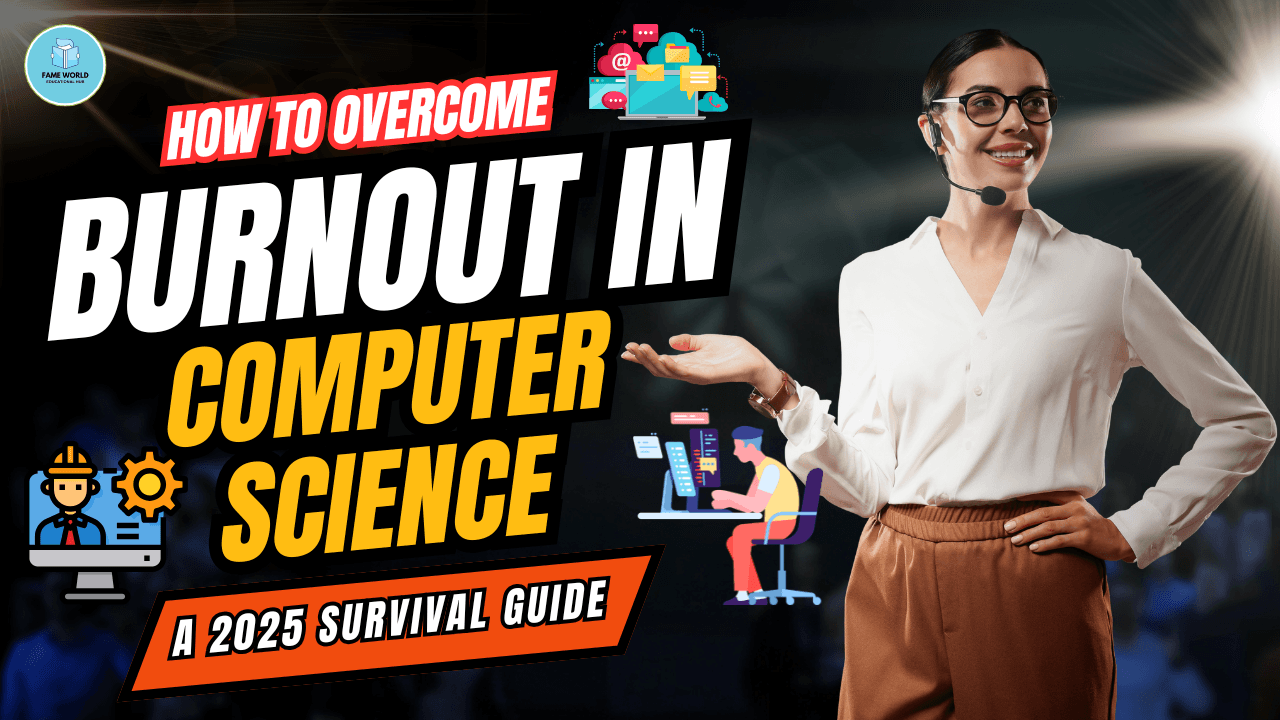Burnout in computer science is a growing concern, especially with the fast-paced demands of the tech industry. Long hours, constant innovation, and a high-pressure environment can leave even the most passionate developers feeling drained. This survival guide is tailored to help computer science professionals and students thrive in 2025, embracing wellness without sacrificing ambition.
What is Burnout?
Burnout is a state of emotional, mental, and physical exhaustion caused by prolonged stress. For computer science professionals, this might manifest as:
- Mental fatigue: Difficulty focusing on coding tasks or solving problems.
- Emotional detachment: Loss of passion for projects you once loved.
- Physical symptoms: Headaches, disrupted sleep, or persistent fatigue.
The World Health Organization (WHO) classifies burnout as an occupational phenomenon, emphasizing the need for proactive management.
Signs of Burnout in Computer Science
- Coding Fatigue: Struggling to debug even simple errors.
- Imposter Syndrome: Constantly doubting your skills despite evidence of success.
- Loss of Curiosity: Avoiding learning new technologies or experimenting with ideas.
- Procrastination: Delaying tasks, even those you find enjoyable.
Interactive Tip
Take a burnout quiz: Rate your energy, motivation, and stress levels on a scale of 1-10 weekly. Patterns over time may highlight early signs.
Causes of Burnout in Computer Science
1. Unrealistic Deadlines
Tight project timelines can lead to overwork.
2. Isolation
Remote work, while flexible, can reduce face-to-face interactions.
3. Perfectionism
A relentless pursuit of flawless code can create undue pressure.
4. Information Overload
Keeping up with evolving tools, frameworks, and methodologies can feel overwhelming.
Strategies to Overcome Burnout
1. Prioritize Work-Life Balance
- Set boundaries: Define clear working hours and stick to them.
- Plan breaks: Use the Pomodoro Technique to take a 5-minute break every 25 minutes.
- Engage in hobbies: Non-tech activities like painting or hiking can re-energize you.
2. Optimize Your Workspace
A clutter-free, ergonomic workspace can enhance focus and reduce physical strain.
- Tools to Consider:
- Ergonomic chairs and desks.
- Blue-light-blocking glasses.
- Noise-canceling headphones.
3. Learn to Say No
Avoid overcommitting to projects. Politely decline tasks that exceed your bandwidth.
Example Script: “I’d love to contribute, but my current workload won’t allow me to deliver quality work.”
4. Focus on Time Management
- Use tools like Trello, Asana, or Notion for task tracking.
- Break down big projects into manageable chunks.
5. Connect with the Community
Join developer forums or attend tech meetups to share experiences and gain perspective.
Recommended Communities:
- GitHub Discussions
- Stack Overflow
- Reddit’s r/ProgrammerHumor
Self-Care Practices
1. Physical Well-being
- Exercise: Regular physical activity reduces stress.
- Nutrition: Opt for brain-boosting foods like nuts, berries, and omega-3-rich fish.
2. Mental Well-being
- Meditation Apps: Use apps like Headspace or Calm to build a mindfulness routine.
- Journaling: Reflect on daily achievements and challenges.
3. Professional Help
Don’t hesitate to seek therapy or counseling. Many companies now offer mental health benefits.
Burnout Prevention Tips for 2025
Embrace AI Tools
Use AI-powered coding assistants like GitHub Copilot or TabNine to reduce repetitive tasks.
Upskill Strategically
Focus on mastering tools relevant to your career goals instead of trying to learn everything.
Take Regular Digital Detoxes
Step away from screens for a day to recharge your creativity.
Your 2025 Action Plan
- Identify Stressors: List tasks or situations causing stress.
- Implement a Wellness Schedule: Dedicate time weekly to self-care.
- Set Realistic Goals: Break large projects into smaller, achievable steps.
- Stay Connected: Build a support network within the tech community.
Interactive Activity: Create Your Anti-Burnout Toolkit
Fill in Your Toolkit
- Favorite Relaxation Apps:
- Go-To Hobbies:
- Daily Affirmation:
- Support Contacts:
Save this list as a quick reference during challenging times.
Final Thoughts
Burnout in computer science is real but manageable. By prioritizing wellness and adopting smart work strategies, you can sustain your passion and productivity. Remember, taking care of yourself is not a setback—it’s an investment in your long-term success.
What’s your go-to method for managing stress in tech? Share your experiences in the comments below!
Additional learning resources:
PYTHON Q&A SERIES – Link
IOT TUTORIAL SERIES – Link
PYTHON PROGRAMMING TUTORIAL SERIES – Link
CAREER TIPS – Link
CLOUD COMPUTING – Link
MERN FULL STACK WEB DEVELOPMENT – Link
DJANGO SERIES – Link
DIGITAL MARKETING – Link
C LANGUAGE – Link
CODING INTERVIEW PREPRATION – Link
NEW AI TOOLS – Link
PYTHONISTA FOR PYTHON LOVERS – Link
ARTIFICIAL INTELLIGENCE – Link
MACHINE LEARNING USING PYTHON – Link
DBMS – Link
PYTHON PROGRAMMING QUIZ SERIES – Link
BLOCKCHAIN TECHNOLOGY TUTORIAL SERIES – Link
NETWORKING QUIZ SERIES – Link
CYBER SECURITY Q&A SERIES – Link
PROGRAMMING RELATED STUFF – Link



